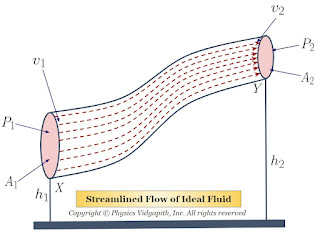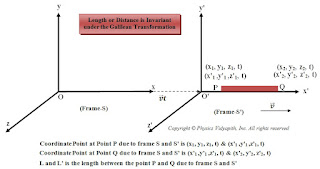The electric potential energy of an electric dipole in the uniform electric field
 |
| Force of moment on an electric Dipole |
de-Broglie Concept of Matter wave
A moving particle is always associated with a wave, called as de-Broglie matter-wave, whose wavelengths depend upon the mass of the particle and its velocity.
h – Planck’s constant
$\nu $ - frequency
| $\lambda=\frac{h}{mv}=\frac{h}{P}\qquad(4)$ |
| $\lambda =\frac{h}{\sqrt{2mK}} \qquad (5)$ |
| $\lambda =\frac{h}{\sqrt{2mqv}}$ |
| $\lambda =\frac{h}{\sqrt{2m_{0}ev}}$ |
| $\lambda =\frac{h}{\sqrt{3mKT}}$ |
- Matter waves are generated only if the material's particles are in motion.
- Matter-wave is produced whether the particles are charged or uncharged.
- The velocity of the matter wave is constant; it depends on the velocity of material particles.
- For the velocity of a given particle, the wavelength of matter waves will be shorter for a particle of large mass and vice-versa.
- The matter waves are not electromagnetic waves.
- The speed of matter waves is greater than the speed of light.
According to Einstein’s mass-energy relation$E=mc^{2}$$h\nu = mc^{2}$$\nu =\frac{mc^{2}}{h}$Where $\nu$ is the frequency of matter-wave.We know that the velocity of matter-wave$ u =\nu \lambda $
Substitute the value of $\nu$ in the above equation$u =\frac{mc^{2}}{h}. \lambda $
$u =\frac{mc^{2}}{h} . \frac{h}{mv}$$u =\frac{c^{2}}{v}$ Where $v$ → particle velocity which is less than the velocity of light. - The wave and particle nature of moving bodies can never be observed simultaneously.
Group velocity is equal to particle velocity
$V$ – Potential energy
Solution of electromagnetic wave equations in conducting media
$\alpha \rightarrow$ Attenuation Constant
$\beta \rightarrow$ Absorption Coefficient and Phase Constant
Electromagnetic Wave Equation in Conducting Media (i.e. Lossy dielectric or Partially Conducting)
- $\overrightarrow{\nabla}. \overrightarrow{E}= \frac{\rho}{\epsilon_{0}}$
- $\overrightarrow{\nabla}. \overrightarrow{B}=0$
- $\overrightarrow{\nabla} \times \overrightarrow{E}=-\frac{\partial \overrightarrow{B}}{\partial t}$
- $\overrightarrow{\nabla} \times \overrightarrow{B}= \mu \overrightarrow{J}$
Modified form:$\overrightarrow{\nabla} \times \overrightarrow{B}= \mu \overrightarrow{J}+\mu \epsilon \frac{\partial \overrightarrow{E}}{\partial t}$
Volume charge distribution $(\rho)=0$
Permittivity of Conducting Media= $\epsilon$
Permeability of Conducting Media=$\mu$
$\overrightarrow{\nabla}. \overrightarrow{B}=0 \qquad(2)$
$\overrightarrow{\nabla} \times \overrightarrow{E}=-\frac{\partial \overrightarrow{B}}{\partial t} \qquad(3)$
$\overrightarrow{\nabla} \times \overrightarrow{H}= \overrightarrow{J}$
$\overrightarrow{\nabla}.\overrightarrow{\nabla}=\nabla^{2}$
$\overrightarrow{\nabla} \times \overrightarrow{B}=\sigma \mu \overrightarrow{E} + \mu \epsilon \frac{\partial \overrightarrow{E}}{\partial t} $
$\overrightarrow{\nabla}.\overrightarrow{\nabla}=\nabla^{2}$
$\overrightarrow{\nabla} \times \overrightarrow{E}= -\frac{\partial \overrightarrow{B}}{\partial t}$
Bernoulli's Theorem and Derivation of Bernoulli's Equation
When an ideal fluid (i.e incompressible and non-viscous Liquid or Gas) flows in streamlined motion from one place to another, then the total energy per unit volume (i.e Pressure energy + Kinetic Energy + Potential Energy) at each and every of its path is constant.$P+\frac{1}{2}\rho v^{2} + \rho gh= constant$
The Area of cross-section $Y$ = $A_{2}$
The velocity per second (i.e. equal to distance) of fluid at cross-section $X$ = $v_{1}$
The velocity per second (i.e. equal to distance) of fluid at cross-section $Y$ = $v_{2}$
The Pressure of fluid at cross-section $X$ = $P_{1}$
The Pressure of fluid at cross-section $Y$ = $P_{2}$
The height of cross-section $X$ from surface = $h_{1}$
The height of cross-section $Y$ from surface = $h_{2}$
The work done per second by force on the liquid leaving the tube at $Y$:
$\Delta W= P_{1} \times A_{1} \times v_{1} - P_{2} \times A_{2} \times v_{2} \qquad(1)$
$\Delta K = \frac{1}{2}m \left( v_{2}^{2} - v_{1}^{2} \right) \qquad(4)$
$\Delta U = mg \left( h_{1} - h_{2} \right) \qquad(5)$
In streamlined motion of an ideal fluid, the sum of pressure head, velocity head and gravitational head at any point is always constant.
Numerical Problems and Solutions of Power
1.) $P=\frac{Work(W)}{Time(t)}$
2.) $P=\frac{F.s}{t}$
3.) $P=\frac{F \: s \: cos \theta}{t}$
4.) $P=\frac{F \: s }{t} \qquad \left( \because \theta =0^{\circ} \right)$
5.) $P=F \: v \qquad \left( \because v = \frac{s}{t} \right)$
Numerical Problems and Solutions
Q.1 A woman pulls a bucket of water of mass $5 Kg$ from a well which is $10 m$ deep in 10 sec. Calculate the power used by her $(g=10 \: m/sec^{2})$.
Solution:Given that:
The mass of bucket of water $(m)=5 \: Kg$ Depth of well $(h)=10 \: m$
The time taken to pull a bucket from the well $t= 10 \: sec $
The value of gravitational acceleration $g=10 \: m/sec^{2}$
The power used $(P)=?$
Now the power used by her:
$P=\frac{W}{T}$
$P=\frac{mgh}{t} \qquad \left( \because W=mgh \right)$
Now substitute the given values in the equation of power:
$P=\frac{5 \times 10 \times 10}{10}$
$P=50 \: Joule/sec=50 W$
Q.2 A man whose mass is $50 \: Kg$ climbs up $30$ steps of the stairs in $30 \: Sec$. If each step is $20 \: cm$ high, Calculate the power used in climbing the stairs $(g=10 \: m/sec^{2})$
Solution:Given that:
Mass of a man $(m) = 50 \: Kg$
Climbs up the number of Steps $(N) = 30$
The time is taken to climb up the 30 steps $(t)= 30 \: sec$
The length or height of one step $(l)=20 cm \: = \: 0.20 \: m$
The total length or height of 30 steps $h=30 \times 0.20 \: m$
The power used in climbing the stairs=?
Now, from the equation of power:
$P=\frac{W}{t}$
$P=\frac{mgh}{t} \qquad \left( \because W=mgh \right)$
Now substitute the given values in the above equation:
$P=\frac{50 \times 10 \times 30 \times 0.20 }{30}$
$P=100 \: Joule/sec = 100 \: W$
Q.3 A horse exerts a pull of $300 N$ on a cart so that the horse-cart system moves with a uniform speed of $18 Km/h$ on a level road. Calculate the power in watts developed by the horse and also find its equivalent in horsepower.
Solution:Given that:
The horse exerts the pull, i.e, force $(F)=300 N$
The unifrm speed of the horse-cart $(v)=18 Km/h$
So the distance moved in $(s)=18 Km=18000m$
The time $(t)=1h= 60 \times 60 sec$
The power developed by the horse$(P)=?$
Now substitute the given values in the above equation:
$P=\frac{3000 \times 18000}{60 \times 60}$
$P=1500 W$
$P=\frac{1500}{746}$
$P=2 \: hp$
Q.4 A man weighing $60Kg$ climbs up a staircase carrying a load of $20 Kg$ on his head. The staircase has 20 steps, each of height $0.2m$. If he takes $10 sec$ to climb, find his power.
Solution:Given that:
The weight of man $(m_{1})=60Kg$
The weight of load $(m_{2})=20Kg$
The number of steps in the staircase $(N)=20$
The height of each step $(H)=10s$
The total mass of the man and load $(m)=m_{1}+m_{2}= 60+20=80 Kg$
The total heght of stair case $(h)=N \times H = 20 \times .2= 4 m$
The power of man: $P=\frac{W}{t}$
$P=\frac{mgh}{t}$
$P=\frac{80 \times 9.8 \times 4}{10}$
$P=313.6 W$
Q.5 A car of mass $2000 Kg$ and it is lifted up a distance of $30m$ by a crane in $1 \: min$. A second crane does the same job as the first crane in $2 \: min$. Do both cranes consume the same or different amounts of fuel? Find the power supplied by each crane? Neglecting power dissipation against friction.
Solution:Given that:
The mass of car $(m)=2000 Kg $
The lifted up distance $(h)=30m$
The time taken by first crane $(t_{1}= 1\: min)$
The time taken by second crane $(t_{2}= 2\: min)$
The work done by each crane:
$W=mgh$
$W=2000 \times 9.8 \times 30$
$W=5.88 \times 10^{5} J$
As both the cranes do the same amount of work, both consume the same amount of fuel.
The power supplied by the first crane:
$P_{1}=\frac{mgh}{t_{1}}$
$P_{1}=\frac{2000 \times 9.8 \times 30}{60}$
$P_{1}=9800 W$
$P_{2}=\frac{2000 \times 9.8 \times 30}{1.2}$
$P_{2}=4900 W$
Q.6 The human heart discharges $75 \: mL$ of blood at every beat against a pressure of $0.1 m$ of Hg. Calculate the power of the heart assuming that the pulse frequency is $80$ beats per minute. Density of $Hg=13.6 \times 10^{3} Kg/m^{3}$.
Solution:Given that:
The volume of blood discharge per beat $(V)=75 \: mL = 75 \times 10^{-6} m^{-3} $
The pressure of blood $(P)=0.1 m \: of \: Hg$ i.e.
$P= 0.1 \times 13.6 \times 10^{3} N-m^{-2} \quad (\because P=\rho g h)$
The work done per beat $=PV$
The workdone in 80 beats$W =80 \times PV$
The power of heart:
$P=\frac{80 \times PV}{60}$
$P=\frac{80 \times 0.1 \times 13.6 \times 10^{3} \times 75 \times 10^{-6} \times 9.8}{60}$
$P=1.33 W$
Q.7 A machine gun fires $60$ bullets per minute with a velocity of $700 m/sec$. If the mass of each bullet is $50 g$, then find the power developed by the gun.
Solution:Given that:
The mass of one bullet is $M=50 g$
The number of bullets $N=60$
The mass of $60$ bullets $m=M \times N= 50\times 60 = 300g= 3Kg$
The velocity of the bullet $v=700 m/sec$
The time take to fire $60$ bullets $t=1 \: min = 60 sec$
The power developed by gun:
$P=\frac{W}{t}$
According to the work-energy theorem:
$W=\Delta K$
$P=\frac{\Delta K}{t} $
$P=\frac{m v^{2}}{2t} \quad( \because K=\frac{mv^{2}}{2})$
$P=\frac{3 \times (700)^{2}}{2 \times 60} $
$P=12250 W $
Variation of Mass with Velocity in Relativity
Galilean Transformation Equations and Failure of Galilean Relativity
A point or a particle at any instant, in space has different cartesian coordinates in the different reference systems. The equation which provide the relationship between the cartesian coordinates of two reference system are called Transformation equations.
- The origin of the two frames coincide at $t=0$
- The coordinate axes of frame $S'$ are parallel to that of the frame $S$ as shown in the figure below
- The velocity of the frame $S'$ relative to the frame $S$ is $v$ along x-axis;
So from equation $(5)$, equation $(6)$ and equation $(7)$, we can write as:
The basic laws of physics are identical in all reference system which move with uniform velocity with respect to one another.
The basics laws of physics are invariant in inertial frame.
The basic law of physics are invariant in form in two reference system which are connected by Galilean Transformation
- Galilean Transformation failed to explain the actual result of the Michelson-Morley experiment.
- It violates the postulates of the Special theory of relativity.
Popular Posts
-
Let $S$ be a point monochromatic source of light of wavelength $\lambda$ placed at the focus of collimating lens $L_{1}$. The light beam is ...
-
Angle of Acceptance → "If incident angle of light on the core for which the incident angle on the core-cladding interface equals t...
-
Derivation of interference of light due to a wedge-shaped thin film: Interference of light due to wedge-shaped thin film The wedge...
-
Maxwell's Equations: Maxwell's equation of the electromagnetic wave is a collection of four equations i.e. Gauss's law of elec...
-
Let a plane wavefront be incident normally on slit $S_{1}$ and $S_{2}$ of equal $e$ and separated by an opaque distance $d$.The diffracted l...









